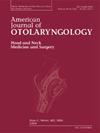婴儿与儿童良性食管狭窄肿胀与球囊扩张的比较
IF 1.7
4区 医学
Q2 OTORHINOLARYNGOLOGY
引用次数: 0
摘要
目的食管扩张的临床结果主要由成人收集的数据组成,可能与儿童不同。比较两组婴儿和儿童良性食管狭窄(BES)的气囊扩张术和肿胀扩张术的安全性和有效性。方法回顾性分析2013 ~ 2024年行食管扩张术的BES患者的医疗记录。A组19例,球囊扩张器18例。对狭窄的病因、狭窄的程度和位置、扩张方法、并发症和扩张效果进行评价和比较。结果37例患者(男21例,女16例,平均年龄6.2岁,范围0.1 ~ 17岁)行124次食管扩张术。狭窄的病因包括腐蚀性狭窄(40.5%)、吻合口狭窄(40.5%)和其他狭窄(18.9%)。除两组各进行一次扩张外,所有患者在扩张后均观察到吞咽困难缓解。技术成功率A组为99.2%,B组为98.9%。扩张后狭窄的平均直径明显增加(P <;0.0001)。30例患者(81.1%)经反复扩张后临床症状消退,其余6例患者在随访期间吞咽困难缓解。没有手术相关的死亡或主要并发症,包括食管破裂或大出血。轻度出血是最常见的并发症。结论囊状导管和球囊导管在婴儿和儿童两组BES患者中均安全、有效且耐受性良好。未来需要更多的随机前瞻性研究来验证结果。本文章由计算机程序翻译,如有差异,请以英文原文为准。
Comparison between bougie and balloon dilation of benign esophageal strictures in infants and children
Objectives
The clinical outcomes regarding esophageal dilation are mainly composed of data collected from adults, who are likely to differ from children. The safety and efficacy of the bougie and balloon dilation were compared in two groups with benign esophageal strictures (BES) in infants and children.
Methods
The medical records of the BES patients, who received esophageal dilation between 2013 and 2024, were reviewed retrospectively. Bougie dilators were used in 19 patients (Group A) and balloon dilators in 18 patients (Group B). The etiology of strictures, degree and location of strictures, dilation methods, complications and dilation outcomes of bougie and balloon dilations were evaluated and compared.
Results
Thirty-seven patients [21 males and 16 females with a mean age of 6.2 years (range, 0.1–17)] underwent 124 esophageal dilations. The stricture etiologies included corrosive strictures (40.5 %), anastomotic strictures (40.5 %), and others in 18.9 %. Dysphagia relief was observed in all patients after the dilation, except for one session of dilation in each of the two groups. The technical success rate was 99.2 % in group A and 98.9 % in group B, respectively. The mean diameter of strictures increased significantly after dilation (P < 0.0001). Thirty patients (81.1 %) had clinical symptoms regress after repeated dilations, and dysphagia was relieved in the remaining 6 patients during the follow-up period. There was no procedure-related mortality or major complications, including esophageal ruptures or massive bleeding. Mild bleeding was the most common complication.
Conclusion
Bougies and balloon catheters are safe, effective and well tolerated in both groups with BES in infants and children. More future randomized prospective studies will be needed to validate the results.
求助全文
通过发布文献求助,成功后即可免费获取论文全文。
去求助
来源期刊

American Journal of Otolaryngology
医学-耳鼻喉科学
CiteScore
4.40
自引率
4.00%
发文量
378
审稿时长
41 days
期刊介绍:
Be fully informed about developments in otology, neurotology, audiology, rhinology, allergy, laryngology, speech science, bronchoesophagology, facial plastic surgery, and head and neck surgery. Featured sections include original contributions, grand rounds, current reviews, case reports and socioeconomics.
 求助内容:
求助内容: 应助结果提醒方式:
应助结果提醒方式:


